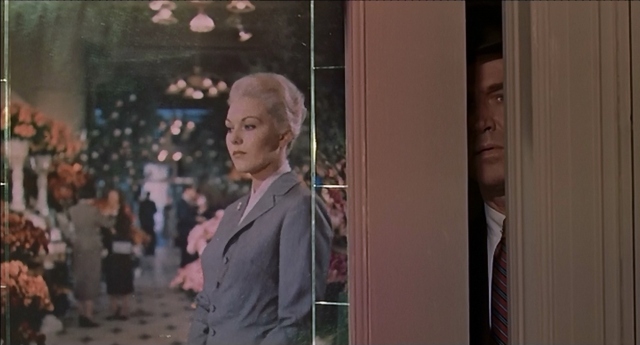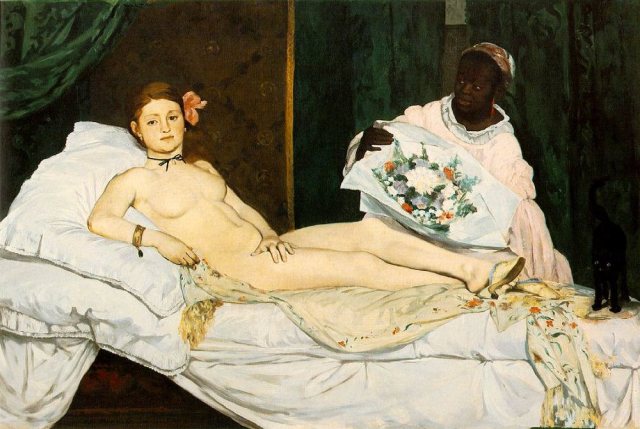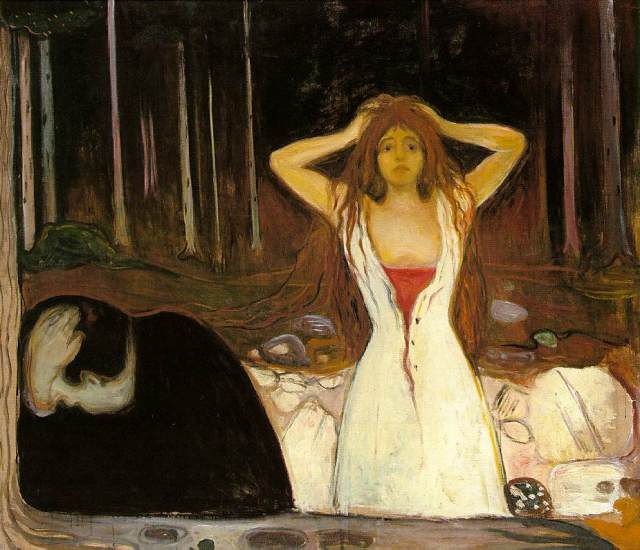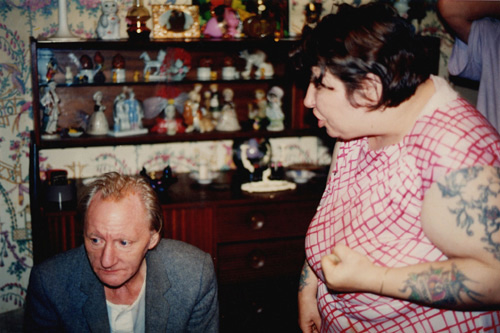Read the chapter by Laura Mulvey called Visual Pleasure and Narrative Cinema on pps 381 – 389 of the course reader making notes.
Notes on the Gaze
Sturken and Cartwright (2009) define the in relation to visual arts as:
“the relationship of looking in which the subject is caught up in the dynamics of desire through trajectories of looking and being looked at among other people.” (Sturken and Cartwright, 2009: 442)
The gaze can be both motivated by the subjects desire for control over the object it sees, and the object can likewise capture and hold the look.
Pooke and Newall (2008) assert that in the field of art, gaze refers to the viewers engagement with the art object and is frequently suggestive of a power dynamic between the object and the spectator. The term Gaze is used prominently in film and gender studies.
Modern origins of the gaze are based on psychoanalytic theory and relates to visual and sexual attentions and the implications of gendered human perception that these contain. Gazing is considered central to sexual attraction and has both a positive and negative identification, for example, narcissistic (loving/productive) and nihilistic (hating/destructive.) (Harris, 2006)
D’Alleva (2012) states:
“Looking is powerful. To look is to assert power, to control, to challenge authority.” (D’Alleva, 2012: 104)
A distinction is made between Gaze and gaze (lower case g): Gaze – the process of looking which constitutes a network of relationships, gaze – a specific instance of looking. Freud saw desire as crucial to the process of looking. Lacan saw the Gaze as one of the main manifestations of the four fundamental concepts of psychoanalysis: the unconscious, repetition, transference and drive. For Lacan, the Gaze gives structure and stability to our fantasies of Self and Other. Looking at art is not a neutral process but one where the viewer is a desiring subject open to the captivation asserted by the work being viewed. The function of art is to trap the Gaze because the viewer is (falsely) put in the position of the eye.
Film theorists of the 1970s (such as Laura Mulvey and Christian Metz) used the theories of Freud and Lacan to posit that in cinema the Gaze of the spectator on the image was implicitly male and objectified women on screen. Lacan’s analysis of the Gaze (for example, the mirror-phase) form an important part of feminist discussions of how women are constructed as the object of a ‘male gaze’ in film and visual arts with a particular feminist interest being the relations between looking, imagery and power in society.
Notes on ‘Visual pleasure and narrative cinema’ by Laura Mulvey
In ‘Visual pleasure and narrative cinema’, Laura Mulvey drew on psychoanalytic theories of Freud and Lacan to challenge patriarchal models of viewing. Hollywood cinema of the 1930s-50s was used to illustrate how pleasure in looking is split between the active/male protagonist/hero who possesses the Gaze and moves the action forward, and, the passive/female who is the object of the desire and the object of the Gaze.
Arguing that Hollywood cinema is geared toward male viewing pleasure, and related directly to the construction of the male psyche. This both reinforced patriarchal society and Mulvey used the psychoanalytical paradigms of scopophillia, voyeurism and narcissism:
Scopophillia – the pleasure in looking and being looked at (exhibitionism.) Pleasure in using another person as an object of sexual stimulation through sight. Active scopophillia implies a separation of erotic identity of the subject from the object on the screen. Is a function of sexual instincts.
Voyeurism – the pleasure taken in looking while not being seen to be looking. This carries negative connotations of a powerful, even sadistic, position within the Gaze.
Narcissism – identification with the image seen – linked to construction of the ego. Demands identification of the ego with the object in screen through the spectators fascination and recognition of his like. Is a function of the ego libido.
Mulvey linked pleasure gained from the male gaze in three ways:
- Woman’s objectification in the gaze of the male characters and audience stimulates the pleasures of erotic fantasy.
- Identification with the male protagonist by male viewers links to the development of the ego – identified by Lacan as the mirror-phase: the stage which creates misrecognition in the child’s mind between the actual self and how he sees himself – the ego ideal.
- The male viewer, through the sadistic power of the male protagonist, is able to subdue the threat symbolised by the female’s lack of a penis – symbolic of castration. To avoid this anxiety the female figure is turned into a fetish/fetish object.
Each of these strategies places the female in a position in which she has no control or agency: women are there to be looked at and the watching men project their fantasies onto the females portrayed on screen. The on screen male is a man of action and command which mirrors the underlying assumptions of a phallocentric and patriarchal society. Patriarchal culture positions woman as image and man as bearer of the image.
Mulvey argued that the reason Hollywood cinema followed these conventions of gender roles (women as visual fetishes; spoken for, bearers of meaning, and, men as vigorous agents; speakers, makers of meaning) is because this is hard wired into the social psyche and thus unavoidable. When woman is referred to as the bearer of meaning this is a reference to the way a woman’s body is organised by Lacan’s concept of the signifier of difference – that is the penis she does not have marked by castration and the threat that she is. Her body, which is complete with beauty but damaged by phallic absence, is the fetish that makes the site of the lack – the difference that forms the possibility of meaning and on which language is built.
A common criticism of Mulvey’s paper is that the Gaze she discusses is strictly male (also white and heterosexual) and this view does more to fix identity than free it. However, this misses the point that the essay is a polemic in which the male Gaze is a strategic necessity in order for Mulvey to make the case that although Hollywood narrative cinema appeared to be innocent entertainment it is really an instrument of patriarchal ideology. Despite what they term the “intellectual problems” of some aspects of Mulvey’s work, Lapsley and Westlake (2006) believe that her theories made a difference beyond academia as she rendered visible what had been invisible: the violence within representation and the reproduction of patriarchy within mainstream cinema. She revealed and confronted the self interested and misogynist nature of representations of women by white, middle class heterosexual males and contributed to the transformation of gender based relations of domination.
Watch ‘Vertigo’ and make notes on how it stands up to Mulvey’s analysis.

Scottie, The main protagonist of Vertigo is obsessed: he falls in love with a woman who apparently dies and seeing another woman who resembles her cannot help himself but remake the second in the image of the first – with eventual tragic results. (Hitchcock, in typically sardonic fashion, described the film as a twist on the Hollywood staple ‘boy meets girl, boy loses girl, boy meets girl again, boy loses girl again’ Sammader, 2012) Under scrutiny it is a preposterous story and a commercial flop on release, now however it is regarded as a classic, possibly Hitchcock’s best film and was voted greatest film ever made by the BFI in 2012. Whether intentional or not Scottie’s moulding of Judy into the vision of Madeline has parallels with Hitchcock’s sadistic treatment of actors and his own obsession with a certain type of leading lady, a fetishised cool blonde. It could also be read as an analogy of the Hollywood star system in which the stars (especially the women) are no more than property to the studios.
Themes of the film include desire and artificiality, subjectivity, female objectification and the male Gaze. Hitchcock was influenced by Freud and surrealism and draws on Freud’s theories of scopophillia. Stylistically the film is almost entirely shot from Scottie’s perspective with the audience becoming complicit in his voyeurism. Dreamy tracking shots are used in the sequences where he follows both Madeline and Judy, the camera moves with Scottie and reflect his snatched glimpses, wonderment and desire. The pastel colours of the films design give a overemphasised artificiality which add to the dreamlike quality. Occasionally our gaze is returned by Novak as Madeline/Judy – at these points we feel her accusing our voyeurism. Reflecting on Vertigo’s narrative, the entire film seems completely implausible, particularly why Madeline/Judy would allow herself to be first manipulated into Elster’s murderous scheme and then allow Scottie to change her appearance. The only logical explanation is that, as Mulvey argues, woman is presented as image and man as bearer of the look. This emphasises the inherent sexual imbalance in which the (active) determining male gaze projects its fantasy onto the female figure (passive) which is styled accordingly.
Mulvey has the following to say about Vertigo: the look is central to the plot – oscillating between voyeurism and fetishist fascination. This is typical of Hitchcock with the male hero (James Stewart/Scottie) seeing exactly what the audience sees, his role being to portray the contradictions and tensions experienced by the spectator. The subjective camera of Vertigo predominates with the narrative being almost entirely based around what Scottie sees or fails to see – his erotic obsession and subsequent despair is shown entirely from his point of view. Scottie’s voyeurism is as blatant as is his sadistic side – he follows, watches and falls in love with a perfect image of female beauty and mystery. In the second half of the film his obsessive involvement with image is demonstrated as he tries to reconstruct Judy as Madeline and force her to conform to every detail of his fetish: “Her exhibitionism, her masochism make her an ideal counterpart to Scottie’s active, sadistic voyeurism.” (Jones, 2010: 64) His erotic interest can only be sustained with her playing and replaying her part, through repetition he breaks her down and exposes her guilt – his curiosity wins through and she is punished.
“In Vertigo, erotic involvement with the look boomerangs: the spectator’s own fascination is revealed as illicit voyeurism as the narrative content enacts the processes and pleasures that he himself is exercising and enjoying.” (ibid)
While Scottie is caught within the symbolic order with all of the attributes of the patriarchal super ego, the spectator is lulled into false security and exposed as complicit, caught in the moral ambiguity of looking: “Vertigo focuses on the implications of the active/looking, passive/looked at split in terms of sexual difference and the power of the male symbolic encapsulated in the hero.”
How does the portrayal of some contemporary black music in video match up to Mulvey’s insights?
Snoop Dogg feat Pharrell Drop It Like It’s Hot HD
Contemporary black music – particularly rap music – has a reputation for being a macho domain where image is paramount and for treating women as little more the objects. I do not profess to be an expert on this style of music and spent sometime looking through various music videos on YouTube before coming across this video: ‘Drop it like it’s hot’ by Snoop Dogg feat. Pharrell from 2009. Snoop Dogg is an artist who has been around for years and fulfils many of the stereotypes of what makes a rapper – glamourous surroundings, expensive consumer goods and a sexualised view of women. The women in this video are literally featured to be no more the glamourous window dressing, fawning and fussing over the stars in the video Snoop Dogg and Pharrell. They are shown dancing with the two male musicians, twerking next to a Rolls Royce, stripping, pouring drinks for Snoop Dogg and dancing together in a scene that could represent a club setting. They represent a juvenile wish fulfilment and are entirely there for the scopophillic pleasure of the (supposed) male viewer. The video is so outlandish and offensive that I would be inclined to think it is a parody, however, there is no sense of irony contained in it. As a final aside – I note that most versions of this video have the lyrics edited to remove potentially offensive words. An interesting choice to keep the visual content intact while censoring the lyrics of the song which shows the perceived power of words over images.
Annotate Manet’s ‘Olympia’ in terms of the gaze and the various characters, within and without the image.

Manet’s ‘Olympia’ (1863) was considered scandalous and vulgar when first displayed, interestingly this has nothing to do with the model being nude but rather the unconventional subject depicted and her seemingly oppositional returned gaze. Rather than depicting an idealised subject based on history or myth as was the convention of nineteenth century painting, the model is a prostitute, and, most significantly, rather than complying with codes of humility and compliance her returned gaze is ambiguous and unsettling. Manet based the composition of the painting on Titian’s Venus of Urbino (1538) and comparing the two paintings emphasise the differences and why ‘Olympia’ caused such controversy. Firstly the subject matter – Titian is depicting Venus, an ideal representation of the female form and sexuality while Manet has painted a courtesan, someone not normally presented in paintings. We can deduce ‘Olympia’ is a prostitute as this name was one often used for courtesans – the black cat shown at the bottom of the bed is a symbol of prostitution. (As opposed to the dog shown in Titian’s painting which represents fidelity.) Both of the women in the picture are similarly undressed, reclining and holding one hand over their waist. Titian’s Venus is coy with her head cocked to one side. She has a look that could appear to be adoration or love, there is no sexual connotation to her pose and although she appears relaxed in her nakedness, the hand she holds over her genital area is appears to rest naturally rather than being held for any reasons of modesty. In ‘Olympia’ the model’s hand seems to be placed deliberately, again modesty is not the motivation here rather she is demonstrating control over her body. The position suggests that while her nakedness can be looked at for free, anything further will require payment.
The most striking aspect of Manet’s painting, as previously mentioned, is the way the model in ‘Olympia’ returns our gaze. Unlike Titian’s model her head is held high and points directly out of the painting – there can be no doubt that the subject of her gaze is the viewer. This is further emphasised by the way the black servant in the painting is ignored despite appearing to bring a gift of flowers – her stare seems to challenge the viewer. Given the typical audience at the time would have been white, middle/upper class, western male this surely would have made them feel uncomfortable when confronted by the reality of a depiction of a ‘type’ they would not have been used to seeing represented in panting. The viewer is forced to confront their scopophillia along with the attendant feelings of shame that are linked to this.
Bibliography:
Buchanan, I (2010) Oxford Dictionary of Critical Theory. New York: Oxford University Press inc.
Cousins, M. (2011) The story of film. London: Pavilion Books
D’Alleva, A (2012) Methods and Theories of Art History (2nd Ed.) London: Laurence King Publishing
Foster, H. et al. (2012) Art since 1900: Modernism * Antimodernism * Postmodernism. (2nd ed.) London: Thames & Hudson.
Harris, J. (2006) Art History: The Key Concepts. New York: Taylor & Francis
Howells, R. Negreiros, J. (2011) Visual Culture 2nd Ed Cambridge: Polity Press
Lapsley, R. and Westlake, M. (2006) Film theory: An introduction. (2nd ed.) Manchester: Palgrave.
Macey, D. (2000) The Penguin Dictionary of Critical Theory London: Penguin books
Mulvey, L (1975) Visual pleasure and narrative cinema
pps. 381-390 Evans, J. and Hall, S. (eds.) (1999) Visual Culture: The Reader. London: Sage
pps. 58-65 Jones, A. (ed) (2010) The Feminism and Visual Culture Reader (2nd edition). London: Routledge
Pooke, G. and Newall, D. (2008) The Basics: Art History. Oxford: Routledge.
Samadder, R. (2012) ‘My favourite Hitchcock: Vertigo’ The Guardian, 10th August 2012. Available At: https://www.theguardian.com/film/filmblog/2012/aug/10/my-favourite-hitchcock-vertigo [Accessed 10th October 2016]
Sturken, M. and Cartwright, L. (2009) Practices of Looking: An Introduction to Visual Culture. Oxford: Oxford University Press
Vertigo (1958) Alfred Hitchcock. Dir. USA: Paramount Pictures
Williams, L. (ed.). (1994) Viewing positions: Ways of seeing film. London: Continuum International Publishing Group























